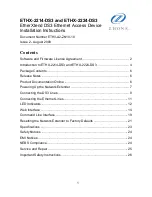
4
Task Remarks
Enabling ACL acceleration for an IPv4 basic or IPv4
advanced ACL
Optional.
Configuring a time range
You can create a maximum of 256 time ranges, each having a maximum of 32 periodic statements
and 12 absolute statements. If a time range has multiple statements, its active period is calculated as
follows:
1.
Combining all periodic statements.
2.
Combining all absolute statements.
3.
Taking the intersection of the two statement sets as the active period of the time range.
To configure a time range:
Step Command
Remarks
4.
Enter system view.
system-view
N/A
5.
Configure a time
range.
time-range
time-range-name
{
start-time
to
end-time
days
[
from
time1 date1
] [
to
time2 date2
] |
from
time1 date1
[
to
time2 date2
]
|
to
time2 date2
}
By default, no time range exists.
Repeat this command with the same time
range name to create multiple statements
for a time range.
Configuring a basic ACL
Configuring an IPv4 basic ACL
IPv4 basic ACLs match packets based only on source IP addresses.
To configure an IPv4 basic ACL:
Step
Command
Remarks
1.
Enter system
view.
system-view
N/A
2.
Create an IPv4
basic ACL and
enter its view.
acl number
acl-number
[
name
acl-name
]
[
match-order
{
auto
|
config
} ]
By default, no ACL exists.
IPv4 basic ACLs are numbered in the range of 2000
to 2999.
You can use the
acl
name
acl-name
command to
enter the view of a named ACL.
3.
Configure a
description for
the IPv4 basic
ACL.
description
text
Optional.
By default, an IPv4 basic ACL has no ACL
description.
4.
Set the rule
numbering
step.
step
step-value
Optional.
The default setting is 5.












































